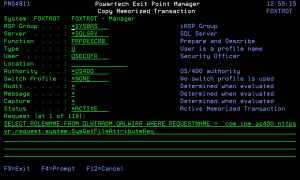How to Get There
From the Exit Point Manager Main Menu, select option 11. On the Work with Memorized Transactions panel, choose option 3 for a Memorized Transaction and press Enter.
What it Does
The Copy a Memorized Transaction enables you to copy a memorized transaction.
Options
Server
A Server in Exit Point Manager is a controlled entry point into your system. These entry points are determined and defined by IBM. Exit Point Manager has assigned easy-to-remember names to these controlled entry points.
Function
A Function, or Server Function, in Exit Point Manager represents a class of operations that a given Server may perform. For example, the *SIGNON Server classifies its operations as those pertaining to changing passwords, generating authentication tokens, and retrieving sign-on information. Exit Point Manager has assigned easy-to-remember names to these Functions, such as CHGPWD, GENAUTTKN and RETRIEVE.
Type
This field is used to indicate whether the associated User field refers to an O/S user profile or a Exit Point Manager User Group.
Valid values are:
User
User represents the identity of the person initiating a transaction as a user profile. The special value *PUBLIC, when used on a rule, means that the rule applies to any User lacking a specific rule. When used as a subset or selection parameter, *PUBLIC means to select all such rules for display or printing. Specify the name of the User for the memorized transaction. You can create a memorized transaction that applies to all Users by specifying the special value *PUBLIC. You can press F4 to see a list of valid values that can be specified.
Location
Location represents the source of a transaction. Location can hold an IP Address, an IP Address Group or the name of an SNA Communications Device. The special value *ALL, when used on a rule, means that the rule applies to any rule means that the rule applies to any Location lacking a specific rule. when used as a subset or selection parameter, *ALL generally means to select all such rules for display or printing. Specify the Location for the memorized transaction. You can create a memorized transaction that applies to all Locations by specifying the special value *ALL.
Authority
Authority represents the action to be taken when a rule is found that matches the data present on a transaction.
Specify the Authority value for the new memorized transaction. You can press F4 to see a list of valid values that can be specified.
The list of valid values may include one or more of these values:
Audit transactions
The Audit transactions flag controls the logging of transactions to the Log Journal set up on the work with Exit Point Manager System Values panel.
Specify one of these values for Audit transactions:
Send messages
The Send messages flag controls the sending of messages to the Log Message Queue set up on the work with Exit Point Manager System Values panel.
Specify one of these values for Send messages:
Capture transactions
The Capture transactions flag controls whether transactions are remembered in Exit Point Manager for later memorization. Once captured, transactions can become Memorized Transactions which can act as rules.
Specify one of these values for Capture transactions:
Switch profile
The Switch profile holds the name of a user profile whose authority is used to process the transaction instead of the authority of the User initiating the transaction. The transaction is executed as, and uses the authority of, this Switch profile.
The job that processes the transaction continues to run under this switch profile until Exit Point Manager processes another transaction request for that job.
Switch profile is allowed only when Authority contains *SWITCH or *MEMSWITCH, if *MEMSWITCH is allowed. Otherwise it must contain *NONE.
Specify the new Switch profile value or one of these special values:
Status
This is the status of the Memorized Transaction.
Possible values are:
Transaction
The Memorized Transaction against which incoming transactions are tested. If a match is found, then this rule will be invoked. Undisplayable characters in the transaction data are replaced by the mid—dot character (-).
You can use the Transaction wildcard character (%) to make a Transaction generic. The wildcard character is valid only at the end of a Transaction string. when you are memorizing or changing a Memorized Transaction, the first occurrence of the wildcard character that was NOT present in the string before you changed it will make the string generic and all data after that wildcard character will be discarded.
Command Keys
F3 (Exit): Exit the panel without processing any pending changes.
F4 (Prompt): Displays a list of possible values from which you may select one.
F12 (Cancel): Exit the panel without processing any pending changes.
